Posted by: Ken @ 1:52 pm
Since taking up photography I have become a more sloppy birder. A pair of binoculars is the best tool to identify a small bird weaving in and out of sight among the branches. If you plan to take a photo of a bird it helps to know what kind it is. Sometimes I have gotten killer binocular views of birds, only to have them disappear the moment I reached for my camera. As a result of such experiences, I often give in to the temptation to raise my camera first.
Although my 420 mm telephoto lens system (an EF300mm f/4L IS USM coupled with a 1.4x extender) provides approximately the same magnification as 8 power binoculars, its viewfinder offers a far less adequate image. In the first place, the field of view is restricted by the camera’s telescopic lens, making it more difficult to find and track the movement of an active target. The view is not nearly as bright as that provided by binoculars. Further, the camera’s image is only in two dimensions, so it is impossible to “see around” the leaves and twigs that may obstruct important identifying features of a small bird. The camera’s auto-focus feature presents an additional challenge, as it will sometimes pick out a little twig that you failed to see in front of the bird, turning the intended target into nothing but a blur.
Case in point. This week, in Kane County, Illinois, I photographed a Philadelphia Vireo for the first time, but did not know this until after I got home. I had heard its song, which I find hard to distinguish from that of the Red-eyed vireo, and then caught a glimpse of what I thought to be just another Warbling Vireo. After taking a few hasty shots, I returned to my search for migrating warblers.
The “Gilvus” group of vireos includes these three rather similar species. Here is a recent photo of the locally common Warbling Vireo, Vireo gilvus.
Take a close look at my next photo, of the overlooked Philadelphia Vireo, Vireo philadelphicus. It is quite similar to the Warbling vireo, but shows a brighter yellow breast and the black line through its eye extends out in front of the eye. I noticed this only after seeing its image displayed on the computer screen.
Bell’s Vireo, Vireo bellii, also included in the Gilvus group, has more subdued plumage. Its normal range is the Central and Western US, but I found this one in Florida, also in my “Fake Hammock.”
I thought vireos got their name from their songs, which are usually rather brief and disconnected phrases that sometimes sound like “vireo… vir-de-lee-o… viree-ee…” However, In Latin, “vireo” means “to be green.”
Although all vireos display a more or less greenish cast to their plumage, the “Green-backed” group is aptly named. It includes the Red-eyed Vireo, Vireo olivaceus.
The Black-whiskered Vireo, Vireo altiloquus, resembles a Red-eyed with a penciled Fu Manchu mustache. This was my first sighting and only photo opportunity, in what I called the “Fake Hammock” near our South Florida home.
Members of the “Eye-ringed” group of vireos appear to be wearing spectacles. This is a Blue-headed Vireo, Vireo solitarius, photographed in direct sunlight, which accents the cool blue color of its head and legs. In poor light the head often looks more gray, as the blue is due to scattering of blue light by the structure of its feathers, not a blue pigment. Unlike the bright blue iridescence of peacocks and grackles, which is caused by reflection of light, the structural blue color is present under nearly all lighting conditions.
The White-eyed Vireo, Vireo griseus, is common as a breeder and winter visitor in South Florida.
Here is a Yellow-throated Vireo, Vireo flavifrons (my poor, and only photo), taken a couple of weeks ago near my NE Illinois home.
Vireos I have seen but not yet photographed include:
- Yellow-green Vireo, Vireo flavoviridis (sometimes included in V. olivaceus), seen once in the Lower Rio Grande Valley.
- Cassin’s Vireo, Vireo cassinii, quite common breeder near our former home in New Mexco.
- Hutton’s Vireo, Vireo huttoni, which I first saw in California. It looks like a robust version of a Ruby-crowned Kinglet “on steroids.”
- Plumbeous Vireo, Vireo plumbeus, which breeds in the mountains of New Mexico.
- Gray Vireo, Vireo vicinior, a hard to find little vireo that bred locally in dry scrub-land such as found on the grounds of Kirtland Air Force Base in Albuquerque, where I enjoyed my first and only sighting. It is a bird of conservation concern because of small population size and loss of its favored habitat.
- Black-capped Vireo, Vireo atricapillus of Southwestern Texas, and
- Thick-billed Vireo, Vireo crassirostris, a West Indies bird that sometimes shows up in southern Florida.













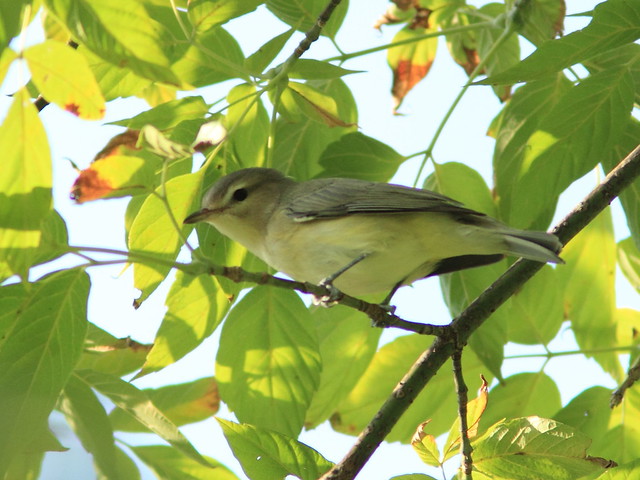
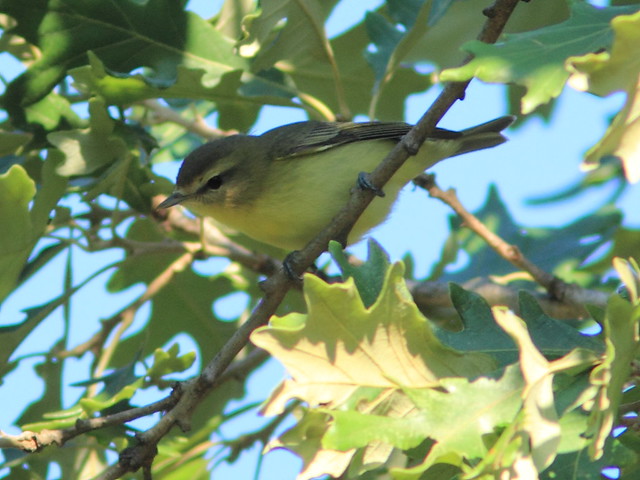
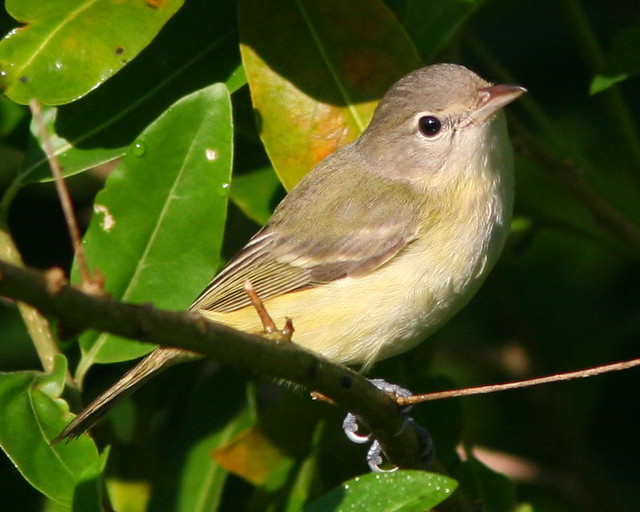
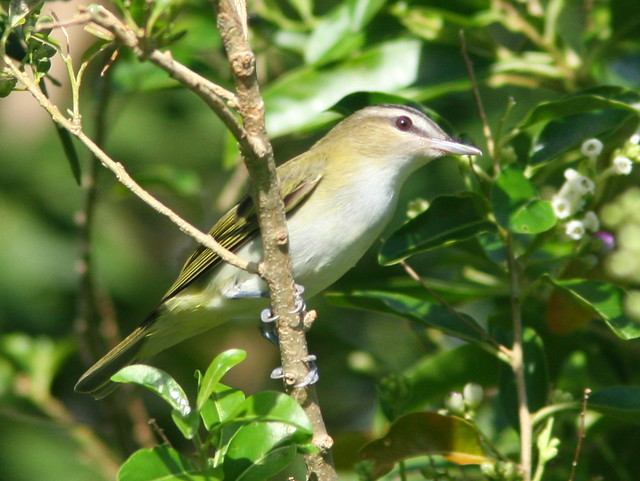

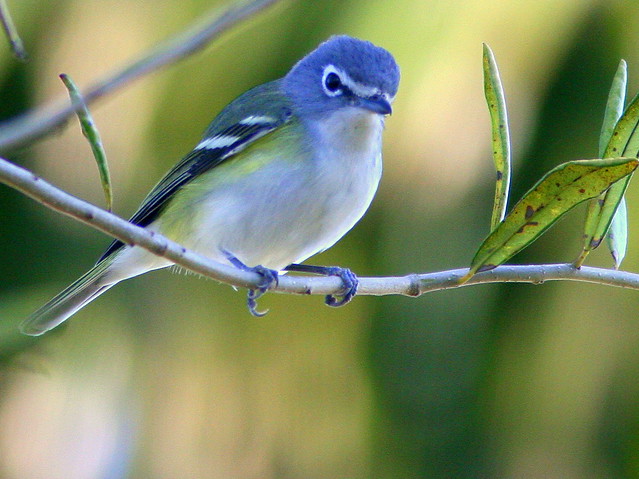
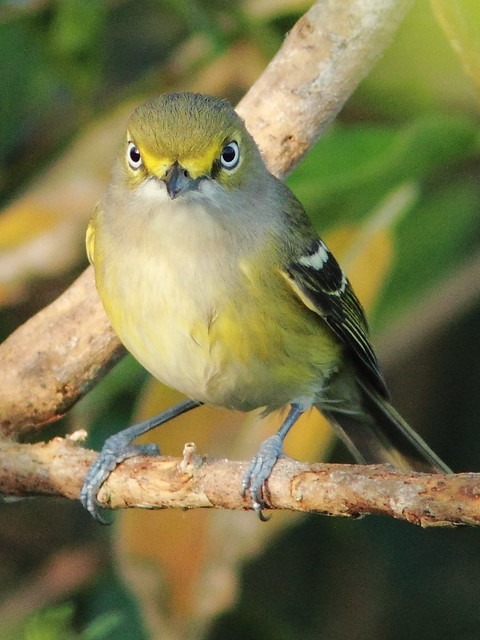
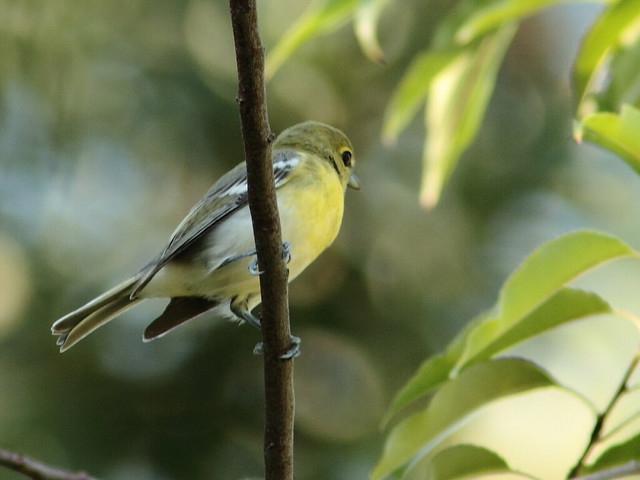
September 9th, 2012 at 2:24 pm Wow Ken! You’ve got a great list of Vireos here, and these are excellent shots! I know what you mean about going for the camera before the binoculars often times, but as I still have so much to learn in finding and IDing field marks anyway, sometimes a blurry photo I can study afterwards is more valuable than a clear but brief binocular view. I’ve found the greatest trouble in trying to incorporate photography is with the feeling of satisfaction that usually comes with a good sighting. If I don’t get a good shot too, then I feel disappointed whereas in my pre-camera days I’d be happy as a clam. I enjoyed this post a lot. Thanks for sharing.
September 9th, 2012 at 4:35 pm Great post, Ken! You have some awesome shots of the Viroe. They really help for id-ing purposes. Happy Birding!
September 9th, 2012 at 5:55 pm Awesome vireos .. LOVE the white eyed view!
September 10th, 2012 at 1:43 pm I’ve been hoping to spot and photograph a white eyed vireo all along, now that I’ve become a birdin’ freak. But after viewing your photos, I want to see a blue headed vireo [will have to google to see if it comes this far south] No matter………your images once again are picture post card perfect. thanks for linking up at the Bird D’Pot.
September 10th, 2012 at 4:31 pm A superb post Ken with cracking images to help identification. I can definitely sympathise with your dilemma between watching or capturing a reasonable image .. I hate to think how many I’ve missed because I wanted to watch the action in 3-D!
September 12th, 2012 at 2:58 am WOW - I learned a LOT from this post! Great images also :)
September 12th, 2012 at 6:12 am Lovely shots, Ken.
September 12th, 2012 at 8:58 am Beautiful post, and photos!! Boom & Gary of the Vermilon River, Canada.
September 12th, 2012 at 11:59 am That Red eyed Vireo is a real stunner. Superb shots.
September 16th, 2012 at 8:40 am Beautiful sequence!! Boom & Gary of the Vermilon River, Canada.
September 16th, 2012 at 6:24 pm Thank you for your kind comments! I have visited all your blogs and really enjoy them!